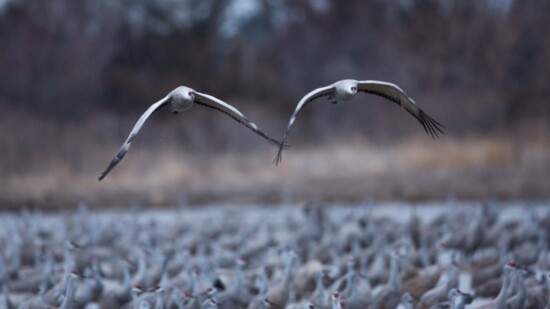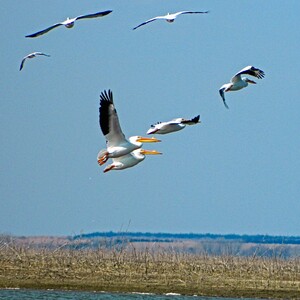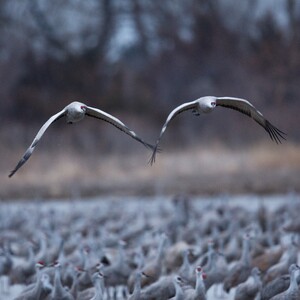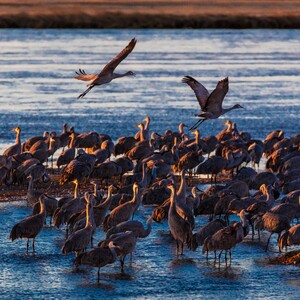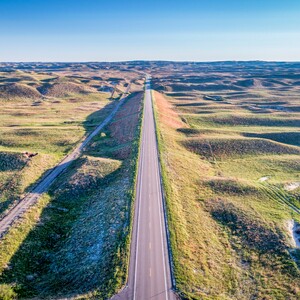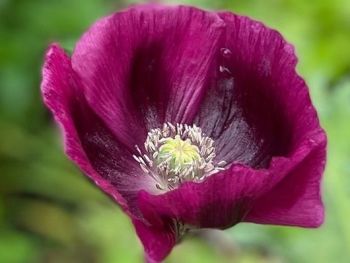There are just a few bedside lights flickering on in the small cities of central Nebraska in early March. Most folks are still asleep in the predawn darkness, but I’m awake, bundled up in many layers, gearing to see an incredible sight. Those in cars passing by on the interstate probably have no idea that there are a half million winged creatures just a few miles away, stirring and getting ready for their day. Later in the day, they may not even notice the corn fields on either side of the highway, filled with majestic blue gray cranes feasting on leftover corn.
This is the epicenter of sandhill crane spring migration – about 600,000 stay here for six week stretches, from late February to mid-April each spring, to fatten up on their way north to their summer homes in Canada, Siberia and Alaska. The Central Platte River Valley, a 75-mile stretch from Lexington to Chapman in south-central Nebraska, is where the four major flyways converge. This is considered by many, including renowned animal behavior expert Jane Goodall, to be one of the top ten animal migration spectacles in the world. Besides cranes, there are millions of ducks, geese, trumpeter and tundra swans and other waterfowl and shorebirds migrating through this Central Flyway. Indeed, eighty percent of the world’s sandhill cranes come up from Mexico, Texas and New Mexico to enjoy a long respite in this ancient instinctive migration staging ritual.
The cranes have been coming here for at least ten thousand years, scientists estimate, to breed and feast in the area of the North Platte River. The river is termed a “braided river,” due to its shallowness and resulting twisted sandbars, offering protection from predators for the enormous cranes, standing some 32-47 inches high, yet only weighing about 7-14 pounds. Gray-blue, with a bright red spot on their heads, their wingspan measures an impressive 5-6 feet across. It’s late March, and the cranes started to arrive mid-to late February. They’ll be gone by mid-April, so this six-week period is very busy, for the birds and for those who flock to the region to view them. There are two riverside sanctuaries where observers can best see the enormous numbers of sandhill cranes rise up from their evening river havens in the early dawn, heading for the endless corn fields surrounding them to feast on corn that missed the harvesting machines. At sunset, spectators come to watch the cranes returning from their day’s work back to the river – first in drips and drabs, two or six or ten at a time, then, twenty, fifty or more, beating their wings madly and somehow, landing as lightly as a parachutist onto a sandbar. There are also blinds at nearby Fort
Kearney State Historical Park from which daytime viewers can watch the cranes feeding in the corn fields from a closer distance.
The Audubon Society’s Rowe Sanctuary’s website warns visitors to dress very warmly and in dark colors (so as to not distract the birds). “You will be standing in an unheated observation blind for about two hours, so dress appropriately. It is better to wear too much than not enough! Wear the warmest coat, clothing and boots that you have!” I did all of that, and brought along thermal heat packets as well – but looking back, next time I would wear even more. The more comfortable one is, the better able to fully appreciate the magnificent spectacle. Rowe, near the small city of Kearney includes 1,300 acres of river habitat and surrounding wetlands, as well as woodlands and mixed-grass prairie.
When we arrived at Rowe, we were led down a sandy ½ mile path. The sound of the early morning cranes was entrancing – sort of a mix of cooing, trilling and purring. We entered the blind – a low, wooden, unheated structure with many open “windows,” and benches to accommodate up to 32 people. At about 7:15 the light started filtering in, and each of us in the blind was glued to an opening, listening and waiting for action to commence. Tiny groups started to fly, to circle, to make ribbons in the air, swirling, dancing, some in lines, others in a motley soup of cranes in every direction. Before long, the sky was full, and still, there were thousands on the sandbars and the cooing, trilling, purring was a pleasant cacophony. It was mesmerizing – a sea of gray-blue wonder. Knowing that these monogamous creatures incredibly stay with their mates and keep track of them fascinated me – they all seemed to look the same! While the morning stillness and approaching dawn are peaceful, we preferred the sunset observation that day, when we returned to Rowe. It was fascinating to see the empty sandbars fill up steadily with the incoming cranes, sometimes just by couples, others in large groups, flapping, cooing and calling.
The sunset oranges and peaches dappled the water with reflections and the resulting scene was truly
spectacular. We hated to leave, but at about 8:30, the light was completely gone. The next day, in the pre-dawn, we visited the Crane Trust Nature and Visitor Center, about 40 minutes from Kearney in the slightly larger city of Grand Island, the Crane Trust is a non-profit organization founded to increase awareness of the Platte River ecosystem. We took a crane viewing blind tour with a trained guide. At Crane Trust, the blinds have plexi-glass with small openings for cameras – nice to break the wind, with superb visibility and a beautiful expanse to see the birds and their activity. It’s not all about sandhill cranes, however, in these parts. There is also an opportunity to view Great White Pelicans en masse at Harlan County Reservoir in Republican City. One morning, we drove about an hour, straight from crane viewing, to the North Shore Marina, to see the enormous, gorgeous birds. These are the largest of eight pelican species and are magnificent, all white with black wing tips, bright yellow bills and orange feeding pouches. A few hundred migrate to Nebraska in the spring and fall. The Harlan County Reservoir is one of the largest bodies of water along the Central Migration Flyway, and attracts many pelicans from early March to early April.
So besides catching up on missed slumber, and viewing multitudes of mesmerizing birds, what else is there to do in this area? Plenty! Kearney and Grand Island have, between them, about 85,000 human residents, including large numbers of immigrants from Mexico, Somalia, Sudan, Cuba, El Salvador and elsewhere, attracted by jobs in the region’s meat-packing plants and agricultural venues. Thus, there are many worthy ethnic restaurants – don’t miss the lively Hispanic market/café at Azteca (delectable, authentic Mexican and Central American dishes)in Grand Island. A ‘don’t miss’ is the Great Platte River Road Archway, a $60 million welcome center/monument, spanning over I-80 (off exit 275,) that marvelously and creatively depicts and tells the story of the 150 years of settlement of the valley, from 1848-1960.
Blinds offer excellent panoramic views of large flocks of cranes, but may not provide good opportunities for close-up photographs unless you have at least a 400mm lens. For the serious nature photographer or enthusiast, overnight photo blinds are set up near major crane roosts on the river. Photography opportunities should be excellent for both still or video cameras.
